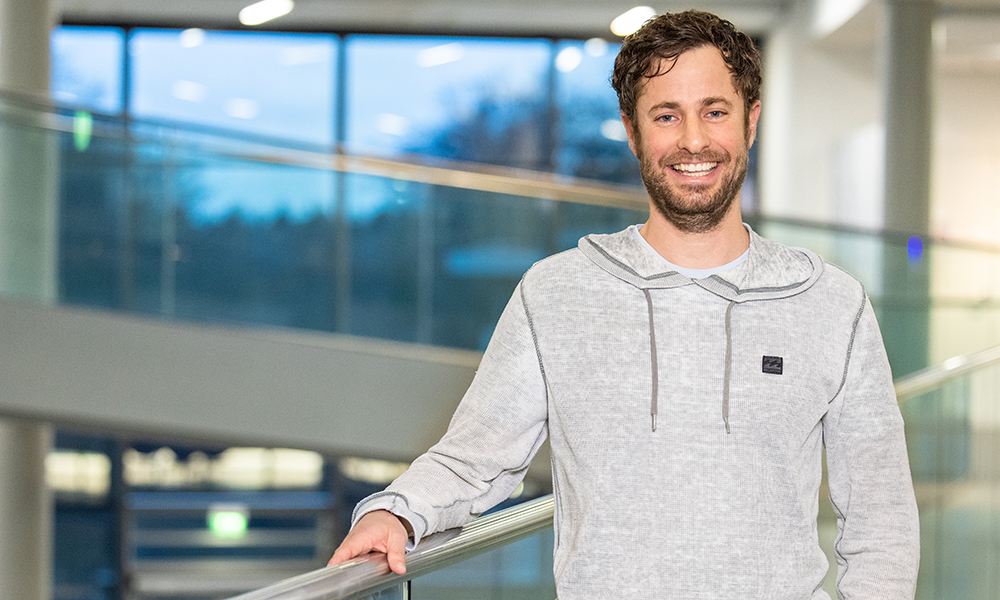
Welcome: Olivier Duss
New group leader’s research to shed light on cellular processes involved in RNA and protein interactions

Seeing how Olivier Duss’s research ‘unfolds’ is an easy pun, in light of the work he and his EMBL group will do with RNA – the chemical cousin of DNA that plays a huge variety of roles inside cells, many of which revolve around making proteins in the right amounts at the right times. Oli’s hope is to reveal the dynamic, intricate events that occur as RNA is born from an enzyme called an RNA polymerase and finds its way to becoming functional. In other words, he hopes to better understand how RNA folds into functional structures. Oli, who comes to EMBL following a joint postdoc position at Scripps Research and Stanford University in California, is now a group leader in EMBL’s Structural and Computational Biology Unit.
Tell me about your research.
My lab is interested in the basic principles of how RNA interacts with proteins. Besides RNA’s role as an information carrier for making proteins, it helps to regulate many cellular processes. While we understand protein structures fairly well, we don’t have that same understanding of how RNA folds and performs cellular functions. RNA molecules are much more dynamic and structurally diverse than proteins. You can imagine RNA as a sticky tape that needs to fold into a functional structure. To better deal with the diverse and dynamic nature of RNA, we use a technique called single-molecule fluorescence microscopy. This allows us to track in real time how single RNA molecules are made, how they fold into specific structures, and how they interact with proteins and other cellular molecules. We then have a real-time movie of the cellular functions of these RNAs. Along with structural biology and other approaches, this gives us a detailed understanding of RNA function and sets the stage for manipulating RNA for therapeutic purposes. One idea that is just being developed, and that we hope isn’t too far-fetched, is to create synthetic functional assemblies. For example, thinking very far ahead, it could be possible to rationally design new dynamic RNA scaffolds that help bring together different enzymes, each one at the right time, to create new metabolic pathways.
What will your group work on at EMBL?
A cornerstone of our research is understanding how RNA folds and starts to interact with proteins while it’s being produced by the RNA polymerase. Specifically, we will investigate transcription – the process in which an RNA polymerase creates an RNA molecule using the cell’s DNA as a template. We’ll study several cellular processes where transcription is coupled to the assembly of protein–RNA complexes. We’d like to know how transcription affects the assembly of ribosomes – the cell’s protein-making machines – in microbes. We’d also like to know how transcription is coupled to this protein-making process, known as translation, in different bacterial species.
Another thing we want to study is the role of RNA molecules in phase separation. This is a process in which a mixture of substances can form separate regions with different properties, just like a mixture of oil and water will separate. And, just as oil can form droplets in water, so phase separation can create defined regions in a cell that carry out specialised functions. We call these regions membraneless organelles, because – unlike most of the cell’s specialised compartments – they’re not surrounded by a membrane; it’s just this difference in physical properties that keeps them separate from the rest of the cell. We want to understand how RNA molecules help to initiate phase separation and how they regulate when and how specific membraneless organelles form.
What are the medical applications of your work?
While the majority of drugs target proteins or stable protein–RNA complexes, targeting functional RNAs is much more difficult because of their dynamic nature. However, the potential of targeting RNA is huge, because many proteins can’t be targeted by drugs, and the majority of RNA molecules have other roles that don’t involve coding for proteins. RNA starts to fold as soon as it emerges from the RNA polymerase, but usually folds into non-native structures that then need to refold to obtain the functional structure. We would like to find ways of targeting and stabilising these non-native structures, preventing the RNA from ever obtaining a functional fold. We will study the folding of mRNAs in the bacterium that causes tuberculosis. This may ultimately reveal ways to make the bacterium less harmful or even kill it, without affecting other, beneficial microorganisms in the body.
When did you realise you wanted to be a scientist?
I think as soon as I could speak, I started to annoy my parents by constantly asking questions about everything. When I was a bit older, I received a chemistry kit for Christmas. From that moment on, I was totally excited to do experiments, mostly focusing on explosions. I think our neighbours were not really safe at that time.
What do you do when you aren’t doing science?
My three kids, aged between 3 and 11, keep me busy. I also love to play soccer, go snowboarding, and I used to surf in San Diego. I really look forward to when we can meet again with friends and family after these crazy times are over.
What’s the last good movie you watched?
I watched Home Alone with my kids. Not sure if it was a good idea though. Since then, they remind me daily that I look like Marv the burglar.
What’s the best part of your work?
It’s the freedom to explore whatever I’m excited about, to learn new things every day, and to interact with so many different people. I get to understand how life works and to wonder at how amazing it is. I also get to share a little bit of the new knowledge I gain every day – things that no one else has seen before.


